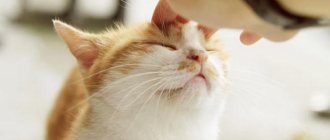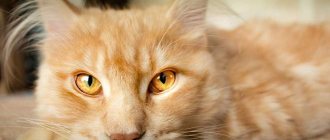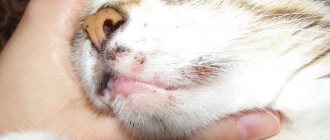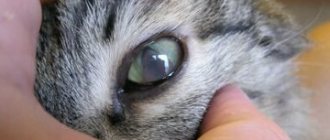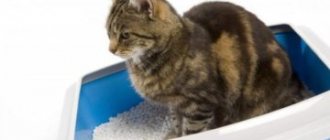Why does a cat limp on its front leg?
In most situations, lameness on the front paw indicates the non-contagious nature of the pathology.
The following are the reasons why a domestic cat falls on its front limb:
- Injuries: sprains, bruises, fractures, punctures, cuts, dislocations, dog bites, splinters. In most cases, upon examination, a wound or swelling is discovered.
- Ankylosing spondylosis , called by analogy with the human disease osteochondrosis. Develops in kittens and older pets. Young animals suffer due to the owners' addiction to overfeeding liver or uncontrolled use of vitamin preparations. Hypervitaminosis A causes excessive calcification and fusion of the vertebrae. The nerves are pinched and the cat begins to limp.
- Arthritis, arthrosis. The disease is typical for older animals in which the cartilage on the articular joints has worn out.
- Dysplasia (improper development, deformation) of the elbow joint. Hereditary disease of large cats. The development of pathology is facilitated by excess weight, adynamia, and excess protein in the diet.
- Osteomyelitis is inflammation of the bones. Most often, fingers are affected when opportunistic microflora (staphylococci) enter the site of a bite or puncture.
- Side effects of injection medications. If a cat is given an injection in the front paw, a pain reaction may develop, which spontaneously disappears after a few days.
Be sure to read:
Third eyelid in a cat: causes, treatment at home, when no intervention is required
Infectious causes of lameness in cats
Lameness on the front paw is a characteristic symptom of calicivirus, a viral disease that affects unvaccinated cats. Pets 2-24 months of age can get sick.
Additional symptoms:
- refusal to eat;
- ulcers and stench from the mouth;
- cough;
- runny nose;
- conjunctivitis.
Lameness occurs suddenly and disappears spontaneously. Another cause of infectious origin is fungal diseases that affect the claws. The horny formations become fragile, break, and it hurts the cat to walk.
A cat is limping on its front leg: how to recognize a fracture or bruise
If the cat is limping, the owner needs to make a preliminary diagnosis in order to develop an algorithm for his subsequent actions.
When a fracture occurs, the following signs are observed:
- the paw swells along the entire length, and not just at the site of injury;
- upon palpation, displacement of the bone or joints is felt;
- the integrity of the skin may be compromised;
- the cat is in severe pain and meows all the time;
- the cat does not try to lean on the broken paw;
- the injured limb looks unnatural.
The bruise is characterized by the following symptoms:
- a hematoma appears at the site of the injury;
- the cat is leaning on a limb, but is limping;
- no displacement of bones or joints;
- skin integrity is preserved;
- the injury site is hot;
- the pet constantly licks the swelling;
- touching the paw causes aggression.
However, the final diagnosis is made by a veterinarian based on the results of an examination and x-ray.
What happens when you get a head injury?
Falls from heights and blows to the head lead to disruption of the central nervous system of the animal. A severe concussion in a cat is equivalent to a brain contusion. That is, in a limited area of the brain, organ tissue is damaged. Along with the immediate impact zone, the brainstem and hypothalamus are affected.
Strong impacts cause destruction of brain tissue
both at the site of impact and at the wall of the skull located opposite. A concussion disrupts the functioning of vital centers. Blood circulation may be impaired. In severe cases, a severe concussion in a cat is accompanied by hemorrhages in the brain tissue and necrosis.
The cat is limping on its front leg: what to do, treatment
If the pet rests on its paw, it does not have a fracture. When an animal is given an injection in the front paw, the lameness is explained by a painful reaction to the medication.
If after 24 hours the swelling has not subsided and the injury site is hot, a visit to the veterinarian is necessary. If you suspect a fracture, your pet should be taken to the clinic immediately and given first aid.
First aid for a cat
In the first minutes after a bruise, cold is applied to reduce blood flow and minimize the volume of hematomas. If 15-20 minutes have passed, the procedure is useless.
Be sure to read:
Why does a cat shake with small tremors: reasons, what to do, when to contact a veterinarian
If a fracture is suspected, especially when the integrity of the skin is broken, the damaged area is cleaned of dirt with a soft cloth. Do not wash the wound with water. The site of injury is treated with Chlorhexidine or Miramistin, the limb is immobilized and taken to the clinic.
Drug therapy
If the injury occurs as a result of a cut, puncture, or a splinter has stuck into the paw, the foreign body is removed and the injured area is treated with an antiseptic. In such a situation, the limb heals in 2-3 days, and the lameness will disappear.
With the development of joint inflammation, pain can occur not only in the front paw. The veterinarian prescribes anti-inflammatory drugs and feed additives containing chondroprotectors.
Elderly animals, depending on their condition, are transferred to therapeutic food for cats suffering from musculoskeletal pathologies.
If the claw is damaged and test results show infection with fungi, external antifungal agents are prescribed. If the fall on the paw is caused by calcivirus, the veterinarian will use medications to treat the underlying disease. When the cause of lameness cannot be determined, antispasmodics or analgesics are used.
Surgical intervention
The clinic examines the damaged paw; if necessary, the veterinarian prescribes laboratory and instrumental tests.
If the claw is damaged, it is trimmed. In case of complex fractures or multiple fragmentation of bones, osteosynthesis surgery or amputation is suggested.
A kitten has a bruised paw: why is contacting our veterinarian the right decision?
1st degree. A characteristic feature of bruises is damage to the inner layers of the skin and subcutaneous tissue. A bruise may be accompanied by the formation of a shallow wound such as an abrasion or scratch. Swelling of the injury site and pain are likely. The pain is mild and may be completely absent.
2nd degree. Bruises of this type are accompanied by the formation of hematomas, separation and rupture of muscles. A common sign of injury is swelling caused by the inflammatory process. The animal has an elevated temperature, increased heart rate and breathing, and the cat limps for a long time.
3rd degree. Such bruises pose a real threat not only to the health, but also to the life of the cat. Third degree damage is accompanied by a change in the appearance of the skin. The concept of bruise in this case means damage to muscle tissue, tendons, the formation of fractures and cracks in bones.
4th degree. Mechanical damage to the limbs of the 4th degree is the most dangerous for a cat. Injuries of this complexity are accompanied by crushing of bones and crushing of tissues. Through external damage to the skin, infection enters the animal’s body. Thus, inflammatory and purulent-putrefactive processes occur. The consequence of injury is often an abscess, sepsis and associated negative processes.
Do not neglect qualified veterinary care to avoid potentially dangerous consequences. A kitten's paw bruise is an injury that requires timely attention.
- The following symptoms indicate a bruised paw in a kitten or cat:
- The appearance of swelling on the animal's paw. Swelling of the injury site is caused by internal bleeding. While the skin remains intact, blood accumulates inside, causing a characteristic swelling.
- Restless behavior of a pet. When a cat receives a mechanical injury, it feels discomfort and its behavior differs from usual. The pet looks for a “closed” place and hides from the owner, presses its injured paw, does not step on it, and often licks the limb.
- Lameness when walking. In most cases, the cat will noticeably limp due to an injured paw.
- The appearance of external signs of damage. A hematoma, bruise, or lymphatic extravasation is likely to be detected in the area of injury. These signs occur against the background of compression and shaking of internal tissues. There may be an abrasion noticeable to the naked eye, swelling due to inflammation.
We invite you to familiarize yourself with: Serengeti cat with the longest paws
In some cases, paw bruises affect internal organs and the osseous-ligamentous apparatus, which provokes the appearance of other symptoms. If you notice that the cat reacts painfully to touching the damaged paw, squeals, or “defends itself” - this is a sufficient reason to contact a veterinarian.
“Street” animals, accustomed to “wild” conditions, can cope with minor bruises on their own. From this point of view, pets require more involvement from the owner. Even if we are talking about a bruise of the first and second degree, first aid is necessary before the veterinarian arrives.
If the bruise is accompanied by bleeding, try to stop the bleeding and treat the wound. This way you will prevent infection. Be sure to wash your hands. Use gauze pads or a bandage to stop bleeding. The use of cotton wool is not recommended, as particles of the material remain in the wound and cause clogging.
If the bleeding is profuse, it is necessary to apply a special tourniquet or use improvised means. Wrap the material tightly around the edge of the damaged vessel or pinch it with your finger wrapped in a handkerchief. Hold your finger on the wound until a blood clot appears, blocking the bleeding. The artery on the hind leg is pinched from the inside of the thigh, and on the front leg – “above the elbow”.
Be sure to treat the wound to prevent infection. Any disinfectant composition is suitable for this, including hydrogen peroxide or brilliant green. After stopping the bleeding and treating the wound, fix the paw and provide the animal with rest.
Any mechanical damage, regardless of the cause, and a bruised paw in a kitten, is stressful for the animal and often causes serious problems later. In some cases, even a slight bruise of the first and second degrees does not go away without a trace for the cat.
If a kitten or adult cat has injured its paw and is limping, then a timely visit to the YA-VET veterinary emergency center will help deal with the injury as quickly as possible without consequences and expensive treatment. Correct diagnosis and qualified assistance from veterinarians who have extensive experience working with cats of any age guarantee that the injury will go away as soon as possible, and the pet will enjoy excellent health and the same activity!
Call us and find out how much emergency veterinary care costs in order to order a visit from specialists without overpayments!
If you find an error, please highlight a piece of text and press Ctrl Enter.

